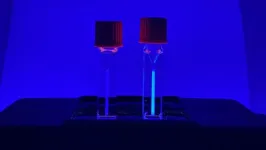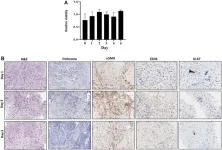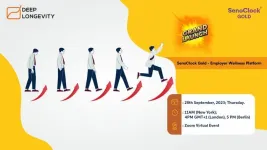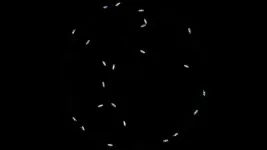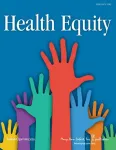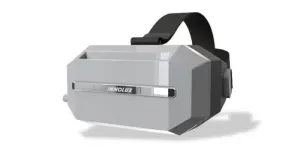(Press-News.org) Chemotherapy as a treatment for cancer is one of the major medical success stories of the 20th century, but it's far from perfect. Anyone who has been through chemotherapy or who has had a friend or loved one go through it will be familiar with its many side effects: hair loss, nausea, weakened immune system, and even infertility and nerve damage.
This is because chemotherapy drugs are toxic. They're meant to kill cancer cells by poisoning them, but since cancer cells derive from healthy cells and are substantially similar to them, it is difficult to create a drug that kills them without also harming healthy tissue.
But now a pair of Caltech research teams have created an entirely new kind of drug-delivery system, one that they say may finally give doctors the ability to treat cancer in a more targeted way. The system employs drugs that are activated by ultrasound—and only right where they are needed in the body.
The system was developed in the labs of Maxwell Robb, assistant professor of chemistry, and Mikhail Shapiro, Max Delbrück Professor of Chemical Engineering and Medical Engineering and Howard Hughes Medical Institute investigator. In a paper appearing in the journal Proceedings of the National Academy of Sciences, the researchers show how they combined elements from each of their specialties to create the platform.
Working collaboratively, the two research teams married gas vesicles (air-filled capsules of protein found in some bacteria) and mechanophores (molecules that undergo a chemical change when subjected to physical force). Shapiro's lab has previously used gas vesicles in conjunction with ultrasound to image individual cells and precisely move cells around. Robb's lab, for its part, has created mechanophores that change color when stretched, making them useful for detecting strain in structures, and other mechanophores that can release a smaller molecule, including a drug, in response to a mechanical stimulus. For the new work, they devised a way to use ultrasound waves as that stimulus.
"We've been thinking about this for a really long time," Robb says. "It started when I first came to Caltech and Mikhail and I started having conversations about the mechanical effects of ultrasound."
As they began researching the combination of mechanophores and ultrasound, they discovered a problem: Ultrasound could activate the mechanophores, but only at an intensity so strong that it also damaged neighboring tissues. What the researchers needed was a way to focus the energy of the ultrasound right where they wanted it. It turned out that Shapiro's gas vesicle technology provided the solution.
In his previous work, Shapiro made use of the vesicles' tendency to vibrate or "ring" like a bell when bombarded with ultrasound waves. In the current research, however, the vesicles are rung so hard that they break, which focuses the ultrasound energy. The vesicles effectively become tiny bombs whose explosions activate the mechanophore.
"Applying force through ultrasound usually relies on very intense conditions that trigger the implosion of tiny dissolved gas bubbles," says Molly McFadden (PhD '23), study co-author. "Their collapse is the source of mechanical force that activates the mechanophore. The vesicles have heightened sensitivity to ultrasound. Using them, we found the same mechanophore activation can be achieved under much weaker ultrasound."
Yuxing Yao, a postdoctoral scholar research associate in Shapiro's lab, says this is the first time that focused ultrasound has been able to control a specific chemical reaction in a biological setting.
"Previously ultrasound has been used to disrupt things or move things," Yao says. "But now it's opening this new path for us using mechanochemistry."
So far, the platform has only been tested under controlled laboratory conditions, but in the future, the researchers plan to test it in living organisms.
The paper describing the research is titled "Remote Control of Mechanochemical Reactions Under Physiological Conditions Using Biocompatible Focused Ultrasound." Additional co-authors are chemistry graduate student Stella M. Luo and Ross W. Barber (PhD '23); Elin Kang (BS '23); Avinoam Bar-Zion, formerly of Caltech and now with Technion-Israel Institute of Technology; Cameron A. B. Smith, postdoctoral scholar fellowship trainee in chemical engineering; medical engineering graduate student Zhiyang Jin (MS '18); chemical engineering graduate student Mark Legendre; Bill Ling (PhD '23), postdoctoral scholar research associate in chemical Engineering; Dina Malounda of the Howard Hughes Medical Institute; Caltech undergraduate students Andrea Torres and Tiba Hamza; and Chelsea E. R. Edwards, formerly of Caltech, now at UC Santa Barbara.
Funding for the research was provided by Arnold and Mabel Beckman Foundation, the David and Lucile Packard Foundation, the Resnick Sustainability Institute, the Institute for
Collaborative Biotechnologies, and the National Institute of General Medical Sciences of the National Institutes of Health.
END
Drug delivery platform uses sound for targeting
2023-09-19
ELSE PRESS RELEASES FROM THIS DATE:
New book examines benefits, harms and ethics of online crowdfunding
2023-09-19
Would you help a complete stranger in desperate need of money, based solely on their social media posts? Simon Fraser University professor and bioethicist Jeremy Snyder examines the complex dimensions of this question in his new book, Appealing to the Crowd: The Ethical, Political, and Practical Dimensions of Donation-Based Crowdfunding (Oxford University Press, 2023) which highlights how online crowdfunding – while helping to meet immediate needs – also impacts privacy and dignity, worsens inequalities, doesn’t solve systemic issues and most often, falls short of its goals.
In ...
Real-time live tissue sensitivity assay for pancreatic adenocarcinoma
2023-09-19
“This approach may allow clinicians to select the most effective therapeutic agents with real time in patients with pancreatic adenocarcinoma.”
BUFFALO, NY- September 19, 2023 – A new research paper was published in Oncotarget's Volume 14 on September 15, 2023, entitled, “Real time ex vivo chemosensitivity assay for pancreatic adenocarcinoma.”
Patient-derived organoids (PDOs) and xenografts (PDXs) have been extensively studied for drug-screening. However, their usage is limited due to lengthy establishment time, high engraftment failure rates and different tumor microenvironment ...
SenoClock Gold: elevating employee health and wellbeing with AI-powered insights
2023-09-19
Empowering Employers
Last year, Deep Longevity launched SenoClock, a B2B platform that grants easy access to aging clocks and an anti-aging recommendation engine. SenoClock has gained popularity among longevity clinics and consumer health companies and is releasing a major update SenoClock Gold that’ll enable any organization to adopt the anti-aging paradigm to improve the quality of life of their workforce. SenoClock highlights the drivers of the aging process in its end-users, and now offers a dynamic view of their progress.
Forward-looking ...
UCF scientist looking at role of fats to curb graft-versus-host disease in hematopoietic stem cell transplantation patients
2023-09-19
UCF Scientist Looking at Role of Fats to Curb Graft-Versus-Host Disease in Hematopoietic Stem Cell Transplantation Patients
BY SUHTLING WONG
Every three minutes, someone in the U.S. is diagnosed with leukemia, lymphoma, or myeloma – cancers of the blood, bone marrow, and lymph nodes.
Treatments for blood cancers often require hematopoietic stem cell transplants but such cells can launch a potentially deadly immunological attack on the patient’s organs called graft-vs-host ...
Ponds release more greenhouse gas than they store
2023-09-19
ITHACA, N.Y.- Though human-made ponds both sequester and release greenhouse gases, when added up, they may be net emitters, according to two related studies by Cornell University researchers.
The studies begin to quantify the significant effects that both human-made and natural ponds have on the global greenhouse gas budget, measurements that aren’t well understood.
“Global climate models and predictions rely on accurate accounting of greenhouse gas emissions and carbon storage,” said Meredith Holgerson, assistant professor of ecology and evolutionary biology at Cornell and senior ...
Researchers identify neurons that guide flies upwind
2023-09-19
New research by Janelia scientists and collaborators at the University of North Carolina at Chapel Hill shows how a cluster of neurons in the fruit fly brain transforms memories about past rewards into actions, helping the fly navigate to find food.
Like other insects, flies turn into the wind, or upwind, to locate the source of attractive odors. The fly’s olfactory system detects and senses odors carried by the wind, guiding the fly to the reward.
In the fly, a brain region called the mushroom body processes and integrates olfactory information. Multiple compartments ...
How stakeholders are working to advance health equity
2023-09-19
New Rochelle, NY, September 19, 2023–A special issue of the peer-reviewed journal Health Equity titled “How Stakeholders Are Working to Advance Health Equity" covers the following areas: changing mindsets, promoting antiracism in health delivery systems, and promoting antiracism in health policy. Click here to read the issue now.
Guest Editors of the special issue are Laurie Zephyrin, MD, MPH, MBA, Senior Vice President, Advancing Health Equity, The Commonwealth Fund; Claire-Cecile Pierre, MD, Associate Chief Medical Officer, Vice President of Community Health, ...
Recent advances in bread research
2023-09-19
Whether light and fluffy or thin and flexible, bread holds an important place in many cultures and cuisines. And despite millennia of baking experience, scientists are still striving to improve this staple food. Below are some recent papers published in ACS journals that report insights into the quality, healthfulness and preparation of bread. Reporters can request free access to these papers by emailing newsroom@acs.org.
“Unraveling the Influence of Wheat Bran Chemical Composition, Lipolytic Enzyme Activities, and Phenolic Components on the Bread-Making Properties of Reconstituted Whole Wheat Flours”
ACS Food Science & Technology
Sept. 13, 2023
Whole-wheat bread contains ...
Expanding the VR immersion comfort zone
2023-09-19
Near-eye displays are emerging as the future of portable devices, providing individuals with immersive virtual reality experiences. The primary objectives in developing these displays are to create immersive experiences and ensure visual comfort. While a larger field of view (FOV) enhances immersion in virtual reality, addressing the Vergence-Accommodation-Conflict (VAC) is crucial for comfortable vision. Researchers have explored innovative approaches to tackle these challenges. A significant breakthrough in near-eye displays is the integration of light field technology. However, earlier light field displays in VR were limited by their ...
UNC Gillings School to host new CDC center for outbreak forecasting, response
2023-09-19
Today, the UNC Gillings School of Global Public Health was named one of 13 funded partners working alongside the Centers for Disease Control and Prevention (CDC) to establish the Outbreak Analytics and Disease Modeling Network (OADM) – an important step towards creating a nationwide outbreak resource to support more effective responses during public health emergencies.
Each funded partner will provide support in innovation, integration or implementation for outbreak analytics, disease modeling and forecasting. The Gillings ...
